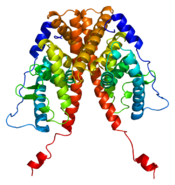Estrogen insensitivity syndrome
| Estrogen insensitivity syndrome | |
|---|---|
 |
|
| EIS results when the function of the estrogen receptor alpha (ERα) is impaired. The ERα protein (pictured) mediates most of the effects of estrogens in the human body. | |
| Classification and external resources | |
| Specialty | Endocrinology |
| OMIM | 133430 |
Estrogen insensitivity syndrome (EIS), or estrogen resistance, is a form of congenital estrogen deficiency caused by a defective estrogen receptor (ER), specifically ERα. Thus, estrogens cannot be recognized and initiate their biological action. Congenital estrogen deficiency can also be caused by a defect in the aromatase enzyme.
In humans, the condition is very rare and only two cases have been described, one male and one female.
In 1994, a 28-year-old man with EIS was reported. He was fully masculinized. At 204 cm, he had tall stature. His epiphyses were unfused, and there was evidence of still-occurring slow linear growth (for comparison, his height at 16 years of age was 178 cm). He also had markedly delayed skeletal maturation (bone age 15 years), a severely undermineralized skeleton, evidence of increased bone resorption, and very early-onset osteoporosis. The genitalia, testes, and prostate of the patient were all normal and of normal size/volume. The sperm count of the patient was normal (25 million/mL; normal, >20 million/mL), but his sperm viability was low (18%; normal, >50%), indicating some degree of infertility. The patient also had early-onset temporal hair loss. He reported no history of gender identity disorder, considered himself to have strong heterosexual interests, and had normal sexual function, including morning erections and nocturnal emissions.
...
Wikipedia
